
![]()
This page is also available in French
![]()
Berlioz visited Geneva twice, but only late in his life, in 1865 (18-ca. 25 August ) and 1866 (15-19 September). As expressed in a letter of July 1858 to his sister Adèle (Correspondance Générale no. 2303; hereafter CG for short), he felt no particular liking for ‘this country of Protestants’. What brought him to Geneva at this stage in his life was the wish to visit Madame Estelle Fornier (née Dubœuf), whom he had met in Meylan in 1815 and fallen in love with at the age of 12. He renewed his acquaintance with her some 49 years later when he went to see her briefly at her home in Lyon on 23 September 1864 (Memoirs). The next time they met was in Geneva in 1865. Madame Fornier had moved there earlier in the year with her newly-wed son Charles Fornier and his wife Suzanne.
In his Memoirs (chapter 3), Berlioz describes Estelle Dubœuf as he knew her in Meylan:
[...] Estelle was eighteen, tall and elegant, with great eyes that smiled provocatively, hair that was worthy of adorning the helmet of Achilles, and feet, I will not say of an Andalusian but of a thoroughbred Parisian, and – pink boots! … I had never seen any before… You will laugh!… I must admit I have forgotten the colour of her hair (I believe they were black) and I cannot think of her without recalling the glitter of her great eyes and at the same time the little pink boots.
Her sight gave me an electric shock; in a word, I was in love with her. I lived in a trance. I hoped for nothing… I knew nothing… but I felt a deep anguish in my heart. Entire nights I would spend in despair. During the days I would hide in the maize fields, in the secret corners of my grandfather’s orchard, like a wounded bird, suffering in silence. Jealousy, that pale companion of even the purest love, would torment me at the merest word spoken by any man to my idol.
By the time Berlioz met her in Lyon and later in Geneva, her beauty had completely vanished, but his feelings for her had not. After his visit to Lyon, in a letter to Princess Carolyne Sayn-Wittgenstein, dated 19 October 1864 (CG no. 2918), Berlioz writes:
The years have destroyed almost everything in her, one has to reconstruct almost completely in the mind her splendid beauty; only her goddess-like stature has remained; nevertheless on seeing her I feel such extraordinary rapture that I completely lose any sense of reality…
Madame Fornier and her son’s family first lived at No. 10 Quai des Eaux-Vives (now called Quai Gustave Ador), and later in mid-1866 moved to Les Délices. This house once belonged to Voltaire, from 1755 to 1760, and now houses the Institut et Musée Voltaire [Voltaire Institute and Museum] in honour of the great man. Estelle occupied the room that used to be Voltaire’s library.
In his letter of the 28 September 1866 to his niece Joséphine Suat, Berlioz writes (CG no. 3165):
[…] I found Mme Fornier living in a villa built by Voltaire, which is called Les Délices. She occupies the great man’s library, and her daughter in law and her son occupy the other apartments. There is a fine park with oaks that are five centuries old; the rent for all this is 1200 francs while my flat at rue de Calais costs me 2400. What a blessing railways are! When I have a little more money I will go and have breakfast with her one morning […]
During his brief visits to Geneva, Berlioz would stay at the Hôtel de la Métropole (still extant on what is now called the Quai Général Guisan), on the shores of Lake Léman and overlooking the Jardin anglais (English Garden) and the Mont Blanc Bridge across the lake. Estelle’s residence on the Quai des Eaux-Vives was close by. He would see the family in their home and would go on short walks and drives with them, sometimes with Madame Fornier alone. The family accepted him and grew very fond of him over time.
In the mid 1860s the illness and intolerable pain from which Berlioz had suffered for many years had become more acute, but his short visits to Geneva to see Madame Fornier would give him a respite and make him feel physically better. For example, in a letter to his son Louis from the hotel in Geneva, Berlioz says:
I arrived here yesterday and already feel much better than in Paris… my visit to Madame F** has done me a great deal of good and this morning at the time when the pains arrive, they found the door closed. I was protected by the presence of kind thoughts. Madame Fornier’s family welcomed me as I hoped they would; I am encouraged to come every day, whenever I feel like it. The daughter-in-law, who is ravishing, almost scolds her mother-in-law for showing some awkwardness and reserve in her manner with me, but I hope that after a few more visits this timidity will disappear. I am staying at the Metropole Hotel on the shore of the lake, facing a beautiful garden-square. It is full of air and light and I am three steps from the quai des eaux vives where the Fornier family live.
(19 August 1865, CG no. 3033)
And on his return to Paris he writes to Madame Fornier:
Two or three times a year I will go to adore you in person, for twenty four hours, to see you, listen to you, and breathe your air; then I will hurry back to Paris, proud and happy like a bee carrying its booty and, more than a bee, full of tender gratitude.
(30 August 1865, CG no. 3038)
Similarly to the Princess:
My arrival in Geneva had the result that for two days I was completely relieved of my pains: I could not adore enough my dear doctor for her magnetic influence. But alas! it was too short-lived.
(17 September 1865, CG no. 3046)
And to his niece Joséphine, a year later:
I went to Geneva; I left on Saturday, arrived on Sunday, and returned on Tuesday. It wasn’t long, was it? I will not hide from you that these two nights spent on the train made me very ill. But I would have been more ill if I had not made the trip.
(28 September 1866, CG no. 3165)
Madame Fornier returned to France with her family in April 1867. Charles and his family moved to Paris to a new job, and she went to Saint-Symphorien d’Ozon near Lyon, at the time in the Department of Isère, to live with another of her sons Henri who was about to get married (CG no. 3232, note 1).
![]()
Unless otherwise stated, the 19th century engravings of the Hôtel de la Métropole and the Quai des Eaux-Vives are courtesy of Hôtel Métropole Genève, a souvenir volume published by the hotel administration in the 1980s, a copy of which is in our collection. The original copies of these engravings and photos belong to the Office de Tourisme de Genève, the Bibliothèque Universitaire de Genève BPU, private collections, and the hotel itself.
We would like to express our gratitude to M. François Jacob, the Conservateur of the Voltaire Institute and Museum, for sending us an engraving and a modern photo of Les Délices, taken in winter, from their own collection and for granting us permission to reproduce them on this page.
Pictures of the Hôtel de la Métropole in 1858 and in the early 20th century, the Hôtel Métropole luggage label, the Quai des Eaux-Vives, Geneva, and the Geneva theatre have been scanned from postcards and other items in our collection.
The 2008 photos of the Quai des Eaux-Vives were taken by M. Vincent Arlettaz to whom we are most grateful. All 2011 photos on this page were taken by Michel Austin in May 2011.
© 2008-2013 All rights of reproduction reserved.
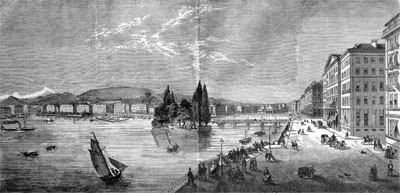
The above engraving, a copy of which is in our collection, was published in an issue of the Journal Illustré in 1864. The Mont Blanc Bridge, which would pass in front of the Île Rousseau across the two banks of the Lake Léman, was built in 1861-1862 (see the next picture below). That bridge was demolished in 1903 and replaced in the same year with the present Mont Blanc Bridge.

The above engraving, a copy of which is in our collection, was published in Leipzig in the 31 January 1863 issue of the Illustrirte Zeitung.
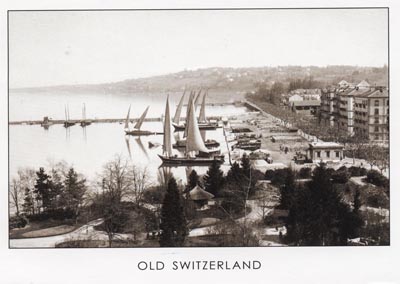
Designed by the architect Joseph Collart, the hotel was initially to be called the Hôtel des Chemins de Fer [Railway Hotel]; its construction was started in 1854 on the site of ancient fortifications which had been demolished in the 1840s. On 1 April 1854 the land and the building, still under construction, were sold to the Societé anonyme de l’Hôtel Métropole; the building was completed in 1855. Berlioz, Liszt and Wagner were among the hotel’s early illustrious guests.
The ownership of the hotel has changed hands several times since, and during the Second World War the hotel was placed at the disposal of the Comité international de la Croix-Rouge [the International Committee of the Red Cross]. The name of the hotel has also undergone slight changes over time: Hôtel de la Métropole, Grand Hôtel de la Métropole, Hôtel Métropole et National, Hôtel Métropole Genève, and Swissôtel Métropole Genève (since April 1998).
The hotel was refurbished in 1954 and then underwent an extensive process of renovation and restoration between 1978 and 1982; it reopened in November 1982. In 2004, the year of the 150th anniversary of the hotel, another major project of renovation of the interior, which started in 1999, was completed, leaving the external shell of the building unaltered.
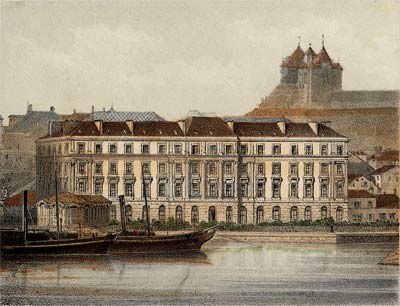
The above lithograph, published in Geneva by Briquet & Fils, is in our collection.
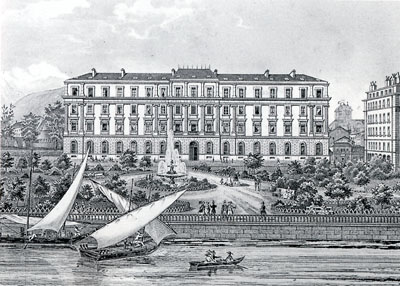
As a result of the construction of the Mont-Blanc bridge across Lake Léman the Jardin anglais [English Garden] was redesigned in 1862 to the layout shown in the above engraving; the small tower to the left of the hotel was demolished in 1864.

The above advert about the hotel was published in a local newspaper in 1868. It is reproduced here courtesy of Swissôtel Métropole Genève – 150 ans 1854-2004, a souvenir volume published by the hotel administration.
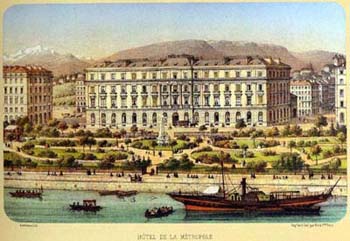
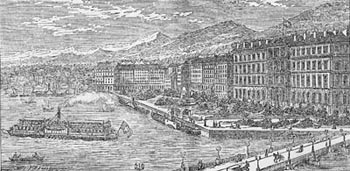
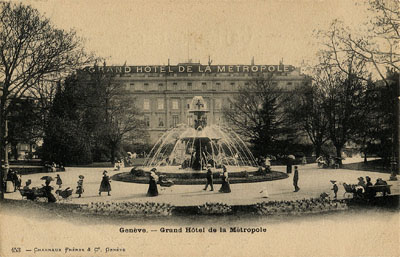
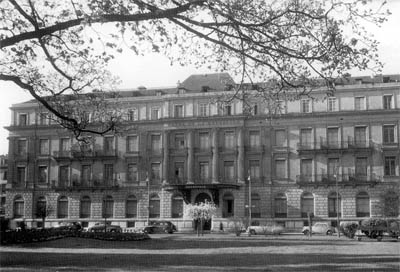
The above photo is courtesy of Swissôtel Métropole Genève – 150 ans 1854-2004, a souvenir volume published by the hotel administration.

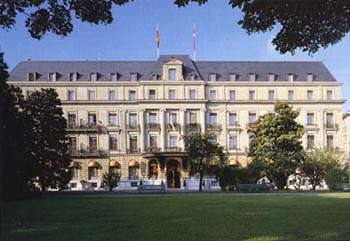
The above photo is courtesy of Hôtel Métropole Genève, a souvenir volume published by the hotel administration in the 1980s.
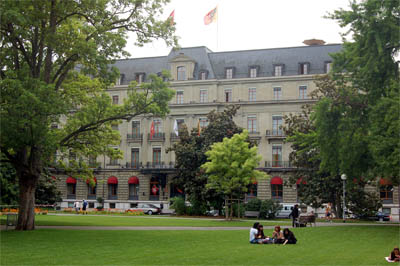
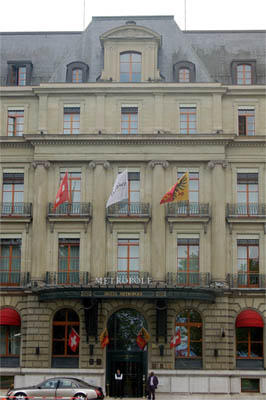
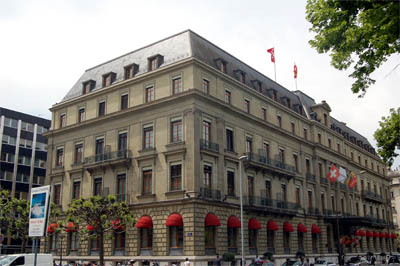


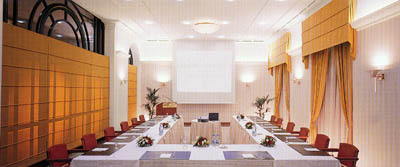
This picture shows a conference room after the 1999-2004 refurbishment project. It is reproduced here courtesy of Swissôtel Métropole Genève – 150 ans 1854-2004, a souvenir volume published by the hotel administration.
This was Voltaire’s home during his sojourn in Geneva from March 1755 to October 1760. Berlioz visited Madame Estelle Fornier, her son Charles Fornier and his family here in September 1866 for two days; the Fornier family lived there from May 1866 to April 1867. Les Délices now houses the Voltaire Institute and Museum.
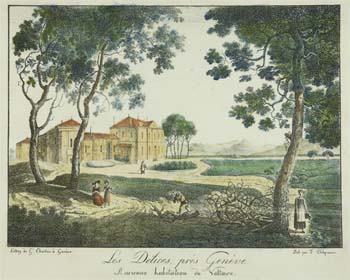
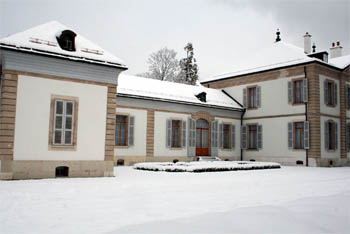
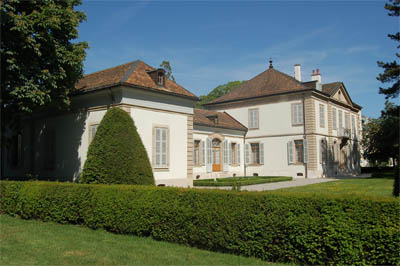
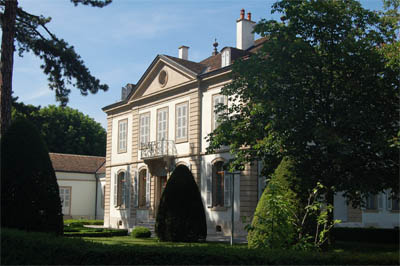
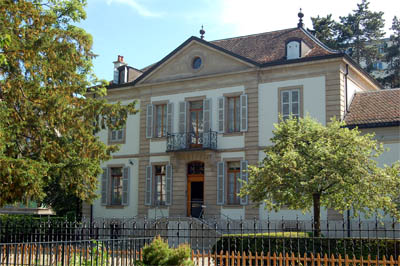
This quai is now called Quai Gustave Ador, after the Swiss statesman Gustave Ador (1845-1928). He was his country’s delegate to the League of Nations (the predecessor of the United Nations), and President of the International Committee of the Red Cross during the First World War. The change of name must have taken place some time after 1937 (see the second postcard below).
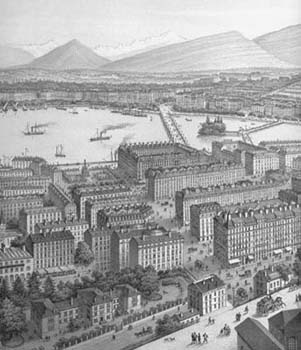
In this engraving the Hôtel de la Métropole is seen on the far side of the Mont-Blanc bridge, a few blocks to the left, just before the second turn to the left and the start of the Quai des Eaux-Vives (see also the large view).
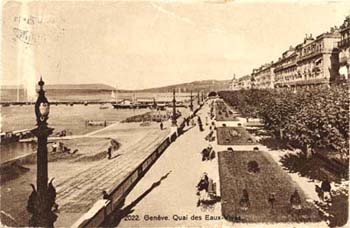
The above card was posted on 19 May 1925.
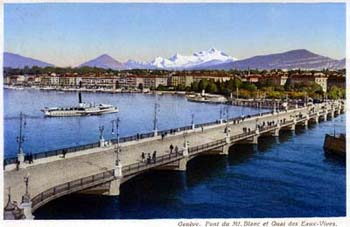
The above card was posted on 12 September 1937.

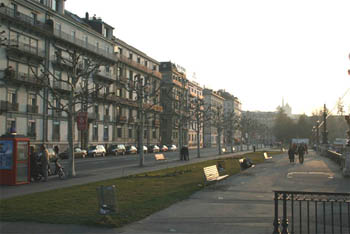
We are most grateful to M. Vincent Arlettaz for sending us the above two photos.
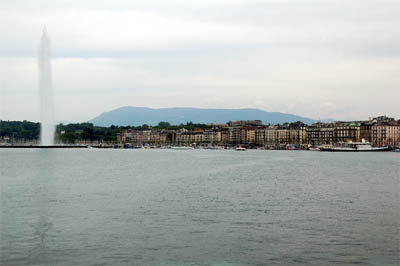

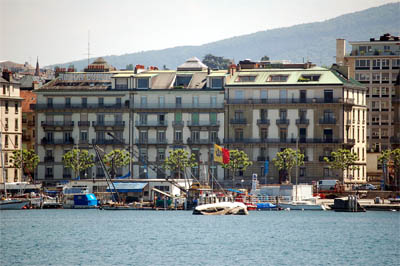
The building No. 10, in the middle of the block in the above photo, is where Madame Fornier lived.
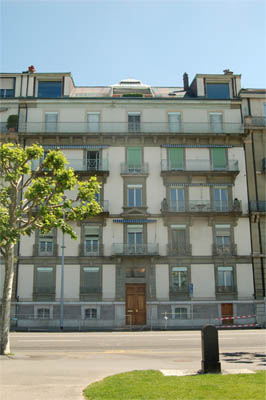
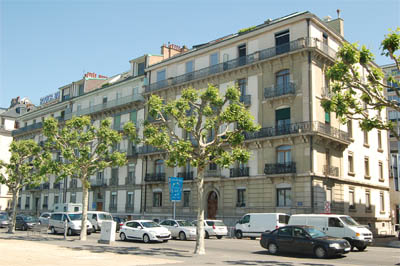
Berlioz was taken on walks and excursions by the Fornier family; these could conceivably have included a look at the opera house, at least from the outside. A new theatre later replaced the old building, designed after the Palais Garnier in Paris by the architect Jacques-Elisée Goss. Renamed the Grand Theatre, the new building was opened in 1879. It was in this theatre that Les Troyens (first two acts only) was first performed in Geneva in 1932, conducted by Albert Paychère. Years later Les Troyens (complete) came back to the Theatre under John Nelson’s baton in 1974 and 2007 (September and October).
The following postcards show the Geneva Theatre in 1862 and 1880.
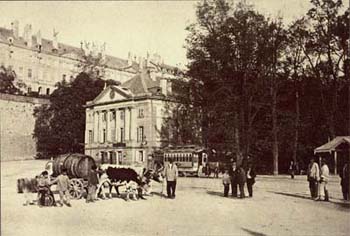
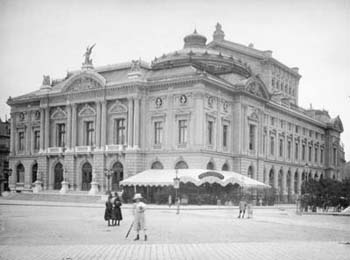
![]()
The Hector Berlioz Website was created by Monir Tayeb and Michel Austin on 18 July 1997; The Berlioz in Geneva page was created on 8 March 2008 and enlarged on 1 June 2011. Revised on 1 June 2023.
© (unless otherwise stated) Michel Austin and Monir Tayeb. All rights of reproduction of the text and images on this page are reserved.